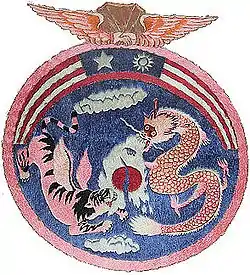| Chinese-American Composite Wing (Provisional) | |
|---|---|
 Emblem of the CACW | |
| Active | 1943-1945 |
| Branch | United States Army Air Forces Republic of China Air Force |
The Chinese-American Composite Wing (Provisional) was a combined United States Army Air Forces and Republic of China Air Force unit. It was administratively assigned under Fourteenth Air Force in China throughout its service from 1 October 1943 – 1 August 1945. CACW succeeded the First American Volunteer Group (AVG) after AVG was disbanded in July 1942. The AVG's famed nickname Flying Tigers was also adopted by CACW. CACW leadership was led by previous AVG commander Clare Lee Chennault, who was promoted to the rank of Major-General.
Its operational units were jointly commanded by American and Chinese air force officers, and its aircraft were manned by American and Chinese pilots and air crewmen.
The 1st, 3rd and 5th Groups of CACW later operate in Taiwan, reorganized as 443rd, 427th and 401st Tactical Fighter Wings of the Taiwanese Republic of China Air Force.
Operational history

Aircraft assigned to the CACW included late-series P-40 Warhawks (with the Nationalist Chinese Air Force blue sky with 12-pointed white sun national insignia, rudder markings and squadron/aircraft numbering) and B-25 "Mitchell" medium bombers. The Mitchells included the B-25D & later B-25J series level bombers, the B-25H series attack/ gunship versions equipped with a 75-millimeter cannon in the nose. The Mitchell markings were like the CACW's fighters, wearing the Nationalist Chinese star insignia on the wings and fuselage. In late 1944, USAAF-marked P-51 Mustangs of the B and C series began to be assigned to CACW pilots. Then, in early 1945, "D" and "K" series arrived. Those series differed in details such as the propeller but shared many external characteristics including the bubble canopy.
All U.S. pilots assigned to the CACW were listed as rated pilots in Chinese Air Force, and were authorized to wearing both pilot's wings of both nations.
During its year and a half of operations, the Chinese and American airmen of the CACW could claim the destruction of 190 Japanese aircraft in air-to-air combat, and 301 more on the ground. The fighters and bombers of the CACW had destroyed at least 1500 Japanese vehicles and sunk several hundred thousand tons of Japanese merchant and naval shipping, in addition they had taken a heavy toll on Japanese ground troops, facilities, railroads and bridges. In that same time, they had lost 35 fighters and 8 bombers to enemy ground fire, and 20 fighters to Japanese aircraft. However, not a single CACW bomber had been lost to enemy fighters, a tribute to the abilities of the Wing's B-25 aircrews, and the quality of the escort protection provided by the Wing's fighter pilots.
The most successful fighter pilot of the CACW was Lt. Colonel William Norman Reed, who had first fought in China as a member of the AVG. As a "Flying Tiger," Reed had destroyed 3 Japanese aircraft in aerial combat and 8 more on the ground. Then returning to China to command the CACW's 7th Fighter Squadron and eventually its 3d Fighter Group, he would destroy an additional 6 Japanese aircraft in aerial combat. According to the book China Bombers by Ken Daniels, Reed was killed while parachuting from a disabled P-40 on December 19, 1944.
Another known CACW member, Captain Ho Weng Toh, was reportedly the last surviving member of the Flying Tigers in Singapore and Asia. In 1944, Captain Ho flew the B-25 Mitchell as a bomber pilot in China with the CACW, after he was trained with the United States Army Air Forces (predecessor of United States Air Force) in Arizona. Captain Ho is also widely considered as the first Singaporean military officer trained by the United States Air Force, with current Singapore Air Force fighter pilots trained at Luke Air Force Base. Becoming a commercial pilot after World War 2, Captain Ho retired in 1980 as Chief Pilot of Singapore Airlines, being one of the airline's pioneering pilots. Captain Ho passed away on 6 January 2024 at 103 years old.[3]
Stations
Most CACW bases existed near the boundary of Japanese-Occupied China, and one "Valley Field" existed in an area within Japanese-held territory. Specific field locations include Hanchung, Ankang, Hsian, Laohokow, Enshih, Liangshan, Peishyi, Chihkiang, Hengyang, Kweilin, Liuchow, Chanyi, Suichwan, and Lingling.
Lineage
- Initially formed on 31 July 1943 as the 1st Bomb Group (Provisional) and the 3rd Fighter Group (Provisional), Republic of China Air Force
- Established as: Chinese American Composite Wing (Provisional), USAAF, and activated on 1 October 1943
- Inactivated on 19 September 1945
Components
|
|
Aircraft
- P-40 Warhawk, 1943–1945
- P-51 Mustang, 1944–1945
- B-25 Mitchell, 1943–1945
References
![]() This article incorporates public domain material from the Air Force Historical Research Agency
This article incorporates public domain material from the Air Force Historical Research Agency
- ↑ Cheung, 2015, pp. 76, 80-81. Hsu Chi-hsiang (徐吉驤-Xu Jixiang) was shot down in his I-15bis in the air combat debut of the A6M Zero... a 20mm cannon shell from one of the Zero-sen fighters scored a direct hit on his amenities kit in the I-15bis luggage compartment, blowing all the bristles off his toothbrush... Hsu would exact some personal revenge on 04 March 1944 over the Japanese airbase at Chiung-Shan (Qiongshan) on Hainan island... shooting down the lead Zero in a flight of three... the flight leader or perhaps the instructor...
- ↑ 蔡, 乔治. "九一三壁山空戰". www.flyingtiger-cacw.com. Archived from the original on 2016-05-21. Retrieved 2021-01-31.
格鬥中,徐吉驤發現自己的座機無論爬升、滾轉、下降還是加速均不如這種兇猛的日機,唯有盤旋半徑尚可和敵機稍比一下高低。雖然他多次占位咬上了日機,但是偏偏他座機的機槍扳機調的太緊,射擊時總是慢半拍,無法把握來之不易的戰機。雖然這樣,徐吉驤仍然沒有脫離戰場,因為他認為日機由漢口、宜昌勞師遠襲,油料必然不足支撐久戰,只要在堅持一段時間,便可以利用日機油盡返航的時機予以打擊、糾纏,那時便可以挽回一點面子。也就是這樣的想法,使得大多數的中國飛行員在空中苦苦鏖戰。不料,這次不行了!... 最後,他座機發動機的潤滑油漏光了,這架伊-152在璧山上空停車。徐吉驤迅速判斷了一下形勢,決定不跳傘,以免被兇殘的日機沖傘射擊。他躲掉日機攻擊後奇跡般的迫降在一片稻田裡,飛機被摔得七零八落。幸好燃油、滑油均已耗盡,飛機沒有燃燒。徐吉驤機智地躲在座機殘骸內,等盤旋在頭頂的兩架日機離去後,才爬出完全損壞的座機。
- ↑ https://mothership.sg/2024/01/captain-ho-flying-tiger-pass-away/#:~:text=Somerset%20Youth%20Park%20Captain%20Ho%20Weng%20Toh%20has,passing%20was%20announced%20on%20his%20nephew%27s%20Facebook%20post.
Bibliography
- Cheung, Raymond. OSPREY AIRCRAFT OF THE ACES 126: Aces of the Republic of China Air Force. Oxford: Bloomsbury Publishing Plc, 2015. ISBN 978 14728 05614.
- 徐 (Xú), 露梅 (Lùméi). 隕落 (Fallen): 682位空军英烈的生死档案 - 抗战空军英烈档案大解密 (A Decryption of 682 Air Force Heroes of The War of Resistance-WWII and Their Martyrdom). 东城区, 北京, 中国: 团结出版社, 2016. ISBN 978-7-5126-4433-5.
.jpg.webp)